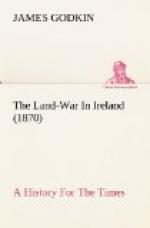CHAPTER XX.
TENANT-RIGHT IN ARMAGH.
Among the undertakers in the county of Armagh were
the two Achesons,
Henry and Archibald, ancestors of Lord Gosford, who
founded Market
Hill, Richard Houlston, John Heron, William Stanbowe,
Francis
Sacheverell, John Dillon, John Hamilton, Sir John
Davis, Lord Moore,
Henry Boucher, Anthony Smith, Lieutenant Poyntz, and
Henry M’Shane
O’Neill.
In connection with each of these settlements Pynar uses the phrase, ‘I find planted and estated.’ What he means is more fully explained in his reference to the precinct of Fews, allotted to Scottish undertakers, where Henry Acheson had obtained 1,000 acres. The surveyor says: ’I find a great number of tenants on this land: but not any that have any estates but by promise, and yet they have been many years upon the land. There are nominated to me two freeholders and seventeen leaseholders, all which were with me, and took the oath of supremacy, and petitioned unto me that they might have their leases, the which Mr. Acheson seemed to be willing to perform it unto them presently. These are able to make thirty men with arms. Here is great store of tillage.’ The whole of the reports indicate that the Crown required of the undertakers two things. First, that they should themselves reside on the land, that they should build strong houses, fortified with bawns, and keep a certain number of armed men for the defence of the settlement. Secondly, that the English and Scotch settlers who were expected to reclaim the land and build houses, were to have




